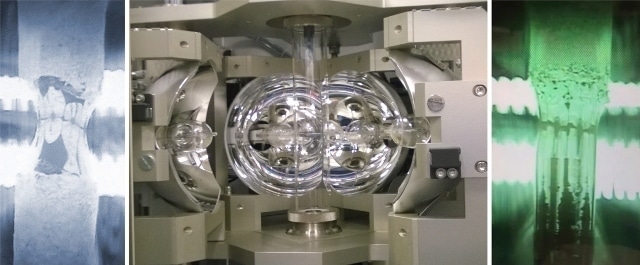Mar 7 2016
Cornell University is leading an effort that will empower scientists, engineers and entrepreneurs throughout the nation to design and create new interface materials – materials that do not exist in nature and possess unprecedented properties – thanks to a $25 million grant from the National Science Foundation (NSF).
 An optical floating zone furnace, center, is used to synthesize new materials together, including single crystals of Pr2Zr2O7, left in blue, and Yb2Ti2O7, right in green. The resulting single crystals are several millimeters in diameter and several centimeters long. (Provided)
An optical floating zone furnace, center, is used to synthesize new materials together, including single crystals of Pr2Zr2O7, left in blue, and Yb2Ti2O7, right in green. The resulting single crystals are several millimeters in diameter and several centimeters long. (Provided)
The Platform for the Accelerated Realization, Analysis, and Discovery of Interface Materials (PARADIM) will invite users to take advantage of various facilities, data and expertise at Cornell and its partner institutions to create new materials from the bottom up, eliciting novel ways for electrons to carry information in solid-state devices and efficiently interact with magnetic, electrical and optical stimuli.
These interface materials produce properties that will impact electronics relevant to national security (quantum computation, universal memories and secure communication), clean energy (improved catalysts), national infrastructure (smart systems enabling low-power signal processing and data storage), and human welfare (miniaturized sensors for medical imaging).
“By providing users with state-of-the-art theory, synthesis and characterization capabilities, this platform marks the beginning of a new paradigm in materials discovery,” said Darrell Schlom, professor of materials science and engineering and PARADIM director. Accelerating such discovery is of national importance, according to the NSF, which says the platform was inspired by the Materials Genome Initiative launched by the White House in 2011.
Empire State Development, New York state’s chief economic development agency, has also committed to invest up to $377,000 annually over the next five years to support the university’s model of innovation, convert concepts and ideas to the commercial sector, and generate a positive impact for both Southern Tier and New York economy.
“Cornell University and its game-changing platform, PARADIM, are helping to transform high-tech business in New York state and across the nation,” said Empire State Development President, CEO and Commissioner Howard Zemsky. “Opportunities offered through this platform will improve research and development, and support the innovative startups and companies that are creating the jobs of the future in the Empire State.”
To balance the desire for a rich nationwide user group and the practicality of managing physical resources across different locations, PARADIM locates its Web-based theory facility at Clark Atlanta University, its bulk-crystal growth facility at Johns Hopkins University and its thin-film growth and characterization facilities at Cornell. PARADIM also leverages expertise from Princeton University as well as existing user facilities such as the Cornell NanoScale Facility, the Cornell Center for Materials Research, and the Johns Hopkins Materials Characterization and Processing Facility.
“There’s no better institution to lead this platform than Cornell,” said Lance Collins, dean of Cornell Engineering. “Advanced materials has been a historic strength for us and our world-class centers and facilities have been drawing some of the greatest scientific minds to our campus for decades.”
Robert Buhrman, senior vice provost for research, says in addition to taking advantage of the university’s facilities, “this new materials innovation platform is particularly well supported by Cornell’s highly collaborative and broadly interdisciplinary approach to materials research. We look forward to the impressive accomplishments and breakthroughs that will undoubtedly ensue,” said Buhrman.
In addition to training materials innovators to work effectively in teams, PARADIM will conduct free summer schools involving hands-on use of facilities to help educate its “community of practitioners” and advance the field through the cross-fertilization of ideas. PARADIM will also serve as a focal point for training the next generation of technologists who are accustomed to designing new interface materials and have the skills necessary to make them a reality.
“PARADIM is a mecca for materials discovery. We look forward to helping users realize their materials-by-design dreams,” said Schlom.
Syl Kacapyr is public relations and content manager for the College of Engineering.